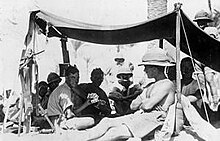XXI Corps Cavalry Regiment
When General Sir Edmund Allenby took over command of the Egyptian Expeditionary Force (EEF) in Palestine in the Summer of 1917 he completely reorganised it.
[9][10] Unlike on the Western Front, where trench lines precluded most mounted action, a corps cavalry regiment in the EEF had an active and varied career: A Sqn DLOY was described as being involved in 'numerous skirmishes, outpost affrays, and pursuits'.
However, the IS Cavalry Bde had a lengthy approach march, came under fire as soon as it emerged from Gaza, and found the village and railway station of Beit Hanoun in front to be stoutly defended by Turkish machine gun detachments.
The defenders here had little stomach, and the force was able to move quickly, the infantry swinging inland and establishing themselves on the crestline after dark, while the engineers developed a water supply in the bed of the wadi.
The Corps Cavalry galloped over the ridge east of the village and brought its Hotchkiss machine guns into action against the retiring Turks, shooting down the team of a 150 mm howitzer that was subsequently captured.
This flank was open and the brigade came under long range machine gun and shrapnel shellfire until the Australians began their own advance in the afternoon.
[2][18][19][20] As the rest of the EEF advanced into the Judaean Hills, XXI Corps continued in the coastal plain, 54th (EA) Division coming up from Gaza to rejoin it.
No 2 Troop of the Herts with an additional Hotchkiss gun was ordered to maintain contact with the Turks and followed them through Fajja, across the Wadi Abu Leja towards the ruined castle at Ras al-Ayn.
XXI Corps Cavalry was up to its establishment in men (the yeomanry had received reinforcement drafts from their 2nd Line regiments at home) but were understrength in horses.
[2][24][25][26] Following the German Spring Offensive on the Western Front in March 1918, the EEF was obliged to send reinforcements to the British Expeditionary Force.
Shortly after B Sqn's arrival Lt-Col Tyrrell ordered all three squadrons to remove their distinctive helmet flashes, apparently to foster a single regimental identity.
[4][7][30][31][a] XXI Corps Cavalry Rgt remained at Sarona for almost five months while the EEF completed its reorganisation and prepared for an autumn offensive.
XXI Corps, with five infantry divisions and a cavalry brigade, had the task of breaking through Turkish trench lines that in places were5 miles (8.0 km) deep.
The mounted patrols followed the Turks as they retreated from one position to another, taking prisoner many Turkish stragglers and entering 'Anebta with an abandoned German field hospital.
The following morning the squadron and 2nd LAMB supported 5th Australian Light Horse Brigade (5th ALH) as it advanced up the road captured Nablus.
By late September the EEF was closing in on Damascus and Allenby ordered XXI Corps to secure the coast and ports of Ottoman Syria.
Extensive engineering work would be required to make it passable for wheeled vehicles, with the danger of the whole cliff shelf falling into the sea.
The task of preparing the half-mile (800 m) track took two-and-a-half days, but was successfully completed so that 2nd LAMB's armoured cars and the 60-pounder guns of 15th Heavy Bty, RGA, could get through.
Even before the work was completed, XXI Corps Cavalry Rgt led its horses up the steps in single file and then rode on to Tyre on 4 October.
This was beyond the capabilities of the infantry or the camels, so XXI Corps Cavalry (riding selected horses), 2nd LAMB and the signals detachment set off early on 12 October.
Here the road made a detour inland, which the armoured cars had to follow, but the cavalry took the more direct coastal track until it reached a deep, dry wadi as darkness fell.
XXI Corps Cavalry and 2nd LAMB held Tripoli until 18 October, when the leading infantry brigade of 7th (Indian) Division arrived, followed by the camel transport the next day.



